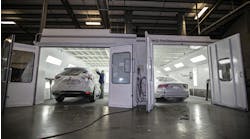Working with engineers at General Motors, the company’s Tire Design Studio in Akron, Ohio developed the one-of-a-kind carved tires for high-profile auto show fitments on the Chevy Code 130R and Tru 140S coupes.
“Our aim is to support our automaker customers by providing them tire design and manufacturing know-how that fits with their requirements,” says Johann Finkelmeier, vice president of original equipment tires.
“While our goal is to capture tire fitment selections on the best high-image vehicles, we know that achievement is possible only through a dedication to providing innovation and quality in our products,” she notes.
“Being chosen to supply the tires for these two fabulous concept cars is a demonstration of Goodyear’s ability to provide tires for virtually any type of vehicle,” says Finkelmeier.
The Code 130R is a four-seat coupe featuring performance-inspired styling and rear-wheel drive. The concept balances turbocharged performance with fuel economy.
The tread of the complementing tires was designed to have the rubber distribution of a Eagle ultra- high performance tire, with styling to complement the vehicle. The tread design is asymmetric while being in concert with the center line of the car, Finkelmeier reports.
Chevy engineers describe the Tru 140S is a front- wheel-drive, “affordable exotic” four-seat sporty coupe. The tires began with the familiar OEM’s chevron logo, evolving into the final design.
The concept tires were manufactured as smooth tread tires in Goodyear’s Luxembourg facility, with the eventual distinctive tread designs carved by a programmed laser. Texture in the tread surface, along with serrations in some of the tread grooves, were also included.
“Probably one of the best-kept styling secrets at any major auto show is the artistic work that’s presented on the tires of many of the high-profile vehicles,” says Paul Maxwell, principal designer at Goodyear’s Tire Design Studio. “There is little doubt that the cars are the stars at these auto shows, but the tires ought to get some attention for their strong supporting role.”
Among past examples of the company’s concept tires for auto shows and other applications are the “Snakeskin” tire (for the 1997 Dodge Copperhead concept car), the “big block” tire (for the Ford F-350 “Tonka” truck in 2002), a “Porsche logo” tire (for the 1993 Porsche Boxster concept), a “sweeping” tread design (for the 2006 Chevrolet Camaro concept), and even the “Bat” tire (for the famous Batmobile movie car).
Seemingly futuristic run-flat tires and wild- looking concept tires aren’t just the result of a tire design engineer’s wild imagination, according to Maxwell. They are requested components for some of the most popular concept vehicles displayed at auto shows, and those vehicles often evolve into reality in the form of production models.
“Concept tire development is important, because it allows us to contribute to automotive design trends that soon may be coming down the road,” Maxwell says. “Communication between the automaker and tire maker is paramount to keeping image and messages consistent through design.”
For more information, visit www.goodyear.com.


